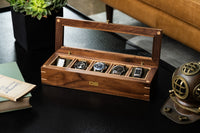Certain military clothing staples are so much part of the larger sartorial zeitgeist that many people simply are unaware of their utilitarian origins. Indeed some, like the M-65 field jacket, were once worn by so many prominent counterculture figures that it’s difficult to imagine them ever having been used on the battlefield. Others, meanwhile, have enjoyed similar sartorial arcs but are much less well known — even by menswear aficionados.
The U.S. Navy’s N-1 deck jacket is one such example.

Original USN N-1 deck jacket - (Image by 66 Supa)
From the 19th century through the early 1940s, the peacoat was issued liberally throughout the U.S. Navy. However, by America’s entry into the Second World War in December of 1941, it became clear to Navy brass that a new garment was needed to outfit the millions of servicemen who were soon to be plying the high seas across multiple theaters. At first, the Navy retooled the popular Winter Combat Jacket — which became known as the “Tanker Jacket” due to its issuance to armored crews and mechanized reconnaissance unit personnel — in blue.
While the Winter Combat Jacket performed beautifully on land, the naval version clearly had its drawbacks: Produced from 8.2-oz. cotton twill with a wool lining and knit cuffs, waistband, and collar, this first iteration of what became known as the N-1 simply didn’t hold up against the biting wind, raging waters, and generally harsh climate of life at sea — especially in the Atlantic theater. Additionally, the jacket frequently became fouled on equipment, which is dangerous when working in already unstable conditions such as those on a moving ship.
 Navy N-1 Deck Jacket worn by sailor Antonio Guevara painted with the image of his submarine USS Jallao - (Image by A Fine-Tooth Comb)
Navy N-1 Deck Jacket worn by sailor Antonio Guevara painted with the image of his submarine USS Jallao - (Image by A Fine-Tooth Comb)
In 1943, the Navy released an updated take on the N-1. Made from an olive drab shell in Bedford cord — a type of corded cotton with excellent waterproof and windproof properties named for the old textile manufacturing center of New Bedford, MA — it was now insulated with double-faced alpaca rather than wool, with added eyelet vents beneath the arms for air ventilation. The previously snag-prone knit cuffs were retooled to sit farther up within the arms, while a drawstring was added to the bottom of a lengthened body for better protection against the elements.
The jacket was closed via a brass Talon zipper covered with a button-down placket. Due to how the buttons are situated slightly right of center, the N-1 thus takes on a slightly asymmetrical look, which is balanced by the addition of two chest pockets either side of the closure. Completely devoid of extraneous adornment, it conveys a “strictly business” aesthetic in excess of that of many other military garments.
 An outlaw biker wearing an N-1 jacket alongside a "new friend" in California (image by LIFE Magazine)
An outlaw biker wearing an N-1 jacket alongside a "new friend" in California (image by LIFE Magazine)
Even so, the wide swathe of material on the back of the jacket provided ample canvas on which to stencil ship names, service stations, ports of call, and other decorative flights of fancy dreamt up by world-weary (and rather bored) sailors. After the war, many of these sailors retained their personal N-1s and could be seen wearing them around the city — or while riding their motorcycles across the country in one of America’s newly minted biker gangs.
 Paul Newman wearing an N-1 deck jacket in the 1950s - (Image by Standard & Strange)
Paul Newman wearing an N-1 deck jacket in the 1950s - (Image by Standard & Strange)
When Paul Newman was photographed on the set of Somebody Up There Likes Me in 1956 wearing what was probably his personally issued N-1 — he served in the Navy between 1943-1946 — he forever cemented the garment in the minds of menswear aficionados as the very definition of cool. (For the record, Steve McQueen also wore one, as did ex-Marine Lee Marvin in Point Blank.) Like many other military menswear staples, it’s since become the focus not only of dedicated collectors, but of companies that make exacting replicas down to the “U.S.N” stenciling that appeared on originals. (Japan’s The Real McCoy’s, in particular, produces a widely praised version, though others are available for more moderate prices from the likes of SM Wholesale USA.)
While not nearly as recognizable as the A-2 flight jacket, the M-65 field jacket, or the peacoat, the N-1 is an American military classic, born of necessity, highly effective, and still talked about with reverence today.












